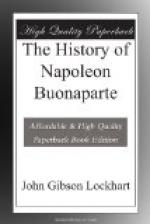Beaulieu, as soon as he ascertained how he had been outwitted, advanced upon Placenza, in the hope of making the invader accept battle with the Po in his rear, and therefore under circumstances which must render any check in the highest degree disastrous. Buonaparte, in the meantime, had no intention to await the Austrian on ground so dangerous, and was marching rapidly towards Fomboi, where he knew he should have room to manoeuvre. The advanced divisions of the hostile armies met at that village on the 8th of May. The Imperialists occupied the steeples and houses, and hoped to hold out until Beaulieu could bring up his main body. But the French charged so impetuously with the bayonet, that the Austrian, after seeing one-third of his men fall, was obliged to retreat, in great confusion, leaving all his cannon behind him, across the Adda; a large river which, descending from the Tyrolese mountains, joins the Po at Pizzighitone—and thus forms the immediate defence of the better part of the Milanese against any enemy advancing from Piedmont. Behind this river Beaulieu now concentrated his army, establishing strong guards at every ford and bridge, and especially at Lodi, where as he guessed (for once rightly) the French general designed to force his passage.
The wooden bridge of Lodi formed the scene of one of the most celebrated actions of the war; and will ever be peculiarly mixed up with the name of Buonaparte himself. It was a great neglect in Beaulieu to leave it standing when he removed his headquarters to the east bank of the Adda: his outposts were driven rapidly through the old struggling town of Lodi on the 10th; and the French sheltering themselves behind the walls and houses, lay ready to attempt the passage of the bridge. Beaulieu had placed a battery of thirty cannon so as to sweep it completely; and the enterprise of storming it in the face of this artillery, and the whole army drawn up behind, is one of the most daring on record.
Buonaparte’s first care was to place as many guns as he could get in order in direct opposition to this Austrian battery. A furious cannonade on his side of the river also now commenced. The General himself appeared in the midst of the fire, pointing with his own hand two guns in such a manner as to cut off the Austrians from the only path by which they could have advanced to undermine the bridge; and it was on this occasion that the soldiery, delighted with his dauntless exposure of his person, conferred on him his honorary nickname of The Little Corporal. In the meantime he had sent General Beaumont and the cavalry to attempt the passage of the river by a distant ford (which they had much difficulty in effecting), and awaited with anxiety the moment when they should appear on the enemy’s flank. When that took place, Beaulieu’s line, of course, showed some confusion, and Napoleon instantly gave the word. A column of grenadiers, whom he had kept ready drawn up close to the bridge, but under shelter of the houses,




